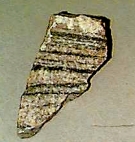Metamorphic RocksMetamorphic rocks are formed by the alteration of pre-existing rocks from exposure to heat and pressure while remaining in a solid form. Metamorphism occurs by breaking bonds between atoms in a mineral so that the atoms rearrange themselves into new, more stable, mineral forms. Rocks are transformed and remain in a solid state because not all the bonds in the rock's minerals are broken - if they were the rock would melt. Metamorphism occurs in solid rock because only some of the bonds between atoms are broken in an unstable mineral. As a result, the freed atoms and ions can migrate to another location within the mineral, or bond with atoms in a different mineral. The end result is to produce minerals that are more stable under the environmental conditions in which they exist. Metamorphism involves the transformation of a pre-existing rock to form new minerals and textures. The original mineral content of a rock can change in several ways. Unstable minerals like clays will breakdown and their elements will recombine to form new minerals. More stable minerals like quartz, will stay quartz but change shape and size to form a new configuration. At high temperatures, atoms and ions may move into a new orientation and bond into more stable forms. Hence, the type of minerals and its texture may change but the chemical composition of the rock itself can stay the same. Rocks buried deep beneath the Earth are exposed to lithostatic pressure, the confining pressure created by the material that sits above a particular location. Lithostatic pressure is equal in all directions and compresses the volume of rock into a denser material. At the contacts between mineral grains, the pressure breaks the bonds between atoms allowing them to migrate toward regions of less pressure where they rebind with other atoms.
Along the boundary of tectonic plates where collision or subduction is occurring,
directed pressure is exerted on
rock. Under these circumstances, pressure is imposed in a particular
direction. Directed pressure flattens and lengthens the rock in the
direction of greatest pressure. The pressure is not great enough to
affect new mineralization however. Instead, directed pressure affects the shape
and arrangement the minerals. Under great pressure, mineral grains
may be smeared or partially melted and recrystallized into bands
aligned perpendi
Figure 14.20 Quartzite is a nonfoliated metamorphic rock formed from sandstone, a sedimentary rock.
Table 14.2 Common Metamorphic Rocks
|
